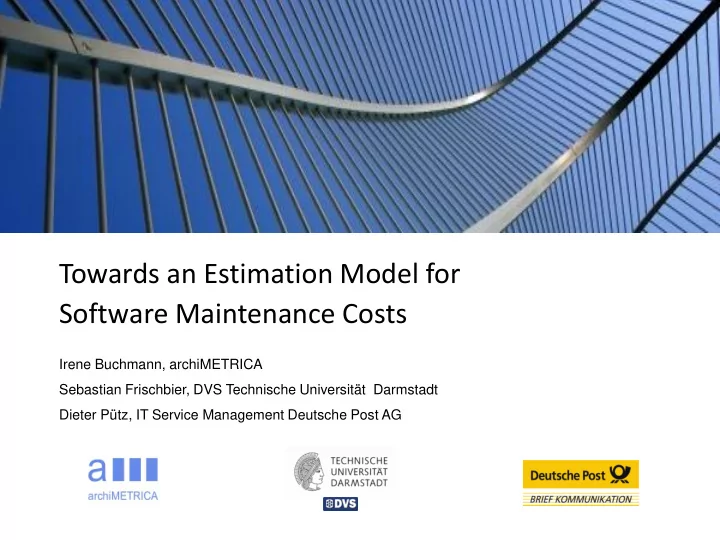

Towards an Estimation Model for Software Maintenance Costs Irene Buchmann, archiMETRICA Sebastian Frischbier, DVS Technische Universität Darmstadt Dieter Pütz, IT Service Management Deutsche Post AG
Corporate Structure Deutsche Post DHL Corporate Center Corporate Functions GLOBAL FOR- SUPPLY BRIEF EXPRESS GBS WARDING, CHAIN FREIGHT CSMR 2011, Oldenburg, March 2, 2011
Business Units Department BRIEF BRIEF Deutschland GLOBAL MAIL PAKET Deutschland • 68 million letters per working • Direct connections to the • 2,3 million parcels a day = 678 day = 21 billion per year customer in over 200 countries million per year • 82 national mail centers • About 2,200 employees • 33 national parcel centers • 80,000 mailmen • About 40 production facilities • 9,900 parcel deliverer • 31,500 postal delivery cars 1) • About 100 selling agencies in • 6,970 employees at parcel Europe, United States and • 3,100 delivery depots centers Asian/Pacific Area • 53,000 delivery districts • 7,050 vehicles for package delivery • 40 million households • 6,800 delivery districs 2) • 108,000 mailboxes • 208 delivery points • 890,000 P.O. boxes • 2,500 Pack stations • 17,000 agencies and points of sale 1) inkl. Verbundzustellung mit 2) davon fremdvergeben: 800 Paketen 1) incl. combined delivery with parcel 2) Including 800 outsourced delivery depots CSMR 2011, Oldenburg, March 2, 2011
archiMETRICA is a management and IT consultancy that has specialized on metric-based IT Management Together with our clients we develop their IT Strategy and KPI based management framework to help align IT to the company’s business strategy • Deduce effective KPIs from the business goals • Measure IT cost , complexity and responsiveness • Support IT planning decisions with metrics • Implement closed loop continuous improvement using Six Sigma CSMR 2011, Oldenburg, March 2, 2011
Managing maintenance efforts requires to (i) characterise applications, (ii) assess intended changes, and (iii) compare bids of different providers Situation Problem Solution • Logistics and underlying • Historically grown Multi-level approach business processes are heterogeneous application consisting of 3 phases to supported by a large-scale landscape application landscape • Landscape consists of more • Blurred line between efforts 1. Transparency and than 150 applications for development, operations standardization and maintenance • Development, operation and 2. Characterize different • Non-uniform data maintenance by external applications in terms providers of maintainability • Provider‘s propositions are • 26% of total IT budget for based on individual pricing 3. Decide on software maintenance (2009) models not always improvement reflecting the genuine effort measures CSMR 2011, Oldenburg, March 2, 2011
A provider‘s pricing model includes a effort estimation model and a profit margin - separating both is essential for comparison of bids and assessment of providers 1 A effort estimation model based on cost- Provider Provider drivers for maintenance allows a rough independent dependent prediction of maintenance costs as a baseline for negotiations 1 2 The profit margin depends on many 2 Effort parameters (e.g. pricing politics, market Estimation Profit Margin situation) Model Cost estimation and profit margin are combined 3 within the service provider’s pricing model (simplistically) Pricing Model 3 Provider independent (depending on the application) factors influencing maintenance costs are blended with provider dependent factors CSMR 2011, Oldenburg, March 2, 2011
Our multi-level approach allows to: (i) create data transparency, (ii) examine current spending, (iii) optimize cost/benefit sustainably I. Create Data Transparency II. Examin Current Maintenance III. Optimize Cost/Benefit Define Identify Collect Analyse Select Relate Categorize React Analyze Analyse Categorize Define metrics applications maintenance & providers tasks Select cost Identify drivers Analyze metrics outliers Construct effort Decide on Collect estimation model impovement metrics measures Criteria to define KPIs Criteria to categorize providers Portfolio of Standardized data Applications to focus on and applications Cost estimation model Maintenance providers CSMR 2011, Oldenburg, March 2, 2011
Have to find a set of suitable metrics to measure applications’ characteristics regarding maintenance, using standard metrics and those specific to Deutsche Post MAIL Standard Metrics Metrics specific to Deutsche Post MAIL • Backfired Function Points Implementation quality • • No. of Programming Languages Code Maturity Regarding coding standards and best practice of • • No. of reported Defects Code Quality Deutsche Post MAIL • No. of Interfaces • No. of Users • No. of Hotfixes Application level complexity • No. of Minor Release Architecture complexity • Middleware Complexity • No. of Major Release metrics used in the operations • Features price model • • No. of Patch Release Complexity Adherence to Deutsche Post • Standardization target architecture Available metrics CSMR 2011, Oldenburg, March 2, 2011
Factors were identified based on their causality (insight) and selected based on their statistical relevance Metrics 1 0,9 Eliminate redundant and 1 0,8 interdependent indicators 0,7 0,6 0,5 Calculate correlation to 2 0,4 basic maintenance effort 0,3 0,2 Select indicators with highest 0,1 3 correlation, lowest p-value 0 and suiteable dataset (n ≥ 22) p-value correlation KPI reporting CSMR 2011, Oldenburg, March 2, 2011
Linear and multiplicative regression models were constructed and evaluated using expert knowledge • Empirical factors Effort will depend on the number of interventions of maintenance team times the average time required for fixing Average time for fixing depends on size times complexity The monotonically growing function needs to be damped with increasing size and complexity • Statistical Analysis was used to find the best fit • Best Model found Application Footprint = PL* FP 0.25 * D 0,3 PL = num Programming Languages FP = num of Function Points Application Footprint D = num of reported Defects CSMR 2011, Oldenburg, March 2, 2011
As part of our future work we are going to improve our approach as a baseline for future pricing models Pricing models III Optimize cost/benefit Define II Measure Examine current Control spending Analyze I Improve Create Data Transparency Time CSMR 2011, Oldenburg, March 2, 2011
Thank You for Your Attention CSMR 2011, Oldenburg, March 2, 2011
Recommend
More recommend